An early transportation facility in Maine was the canal. The need for public support for canals was recognized in 1820 by the state’s first governor William King’s inaugural address.
In 1834 the Board of Internal Improvements was authorized by the Maine Legislature. The Board’s responsibility was to “explore and examine the great water courses of the State, where it may be supposed that canals, roads, railroads or other internal improvements may benefit the State . . . .”
Henry David Thoreau commented on the newly built Telos Canal or Telos Cut, in his essay “Allagash and the East Branch,” in The Maine Woods:
This was another noble lake, called twelve miles long, east and west; if you add Telos Lake, which, since the dam was built, has been connected with it by dead water, it will be twenty; and it is apparently from a mile and a half to two miles wide.
The remnants of once important canals may be found in a variety of places, one of which is the Oxford-Cumberland Canal in Standish and the related Songo Locks in Casco and Naples. In Lewiston, canals were important in serving the once thriving textile mills.
Some have virtually disappeared from the landscape, such as the 18th Century Peterson Canal in Bath, above the New Meadows River. The canal was constructed to divert logs from the Kennebec River by sending them from Merrymeeting Bay to the New Meadows.
Other references to Maine canals are in Fryeburg, Hanover, Saco, Searsmont, Stroudwater, Waterville, Wilton, and Windham.
According to a survey by the American Canal Society in 1974,
In 1793, Charles Barrett of Ipswich. N.H. and one of the first settlers of Barrettsville. later Hope, Maine, secured a charter from the Massachusetts General Court to erect a canal system on the St. George River for transporting farm and forests products down river, and supplies for the settlers up river. He did succeed in opening a section from Round Pond (Union) to Warren (downstream), but became discouraged with such great expense involved that he sold his rights to Gen. Henry Knox (first Secretary of War under President George Washington) in 1795. Gen, Knox continued to build and improve the canal, but revenues were low, and the locks fell into disrepair and decay in 1802, and by his death in 1806, the system ceased to operate.
The Georges River Co. re-opened the 28-mi. waterway in 1847, but changes in trading & population soon spelled its doom.
Additional resources
Anderson, Hayden L. V. Canals and Inland Waterways of Maine. Portland, Me. Maine Historical Society. 1982.
Coburn, Louise Helen. Canal Projects for the Kennebec: 1825 to 1832. Skowhegan, Me. 19??
Maine. Board of Internal Improvements. “Board of Internal Improvements Records, 1834 Dec. 10-1842 May 24.” [Augusta, Me. Maine State Archives]
Rogers, Lore. “The Telos Cut.” The Lumbermen’s Museum. 1966. [University of Maine, Raymond H. Fogler Library, Special Collections]
The Telos Canal: A Lumberman’s Canal near Moosehead Lake, Maine, which Diverts the Water from the Allagash to the Penobscot. Augusta, Me. Maine State Library. 1941.
Thorau, Denry David. The Maine Woods. “Allagash and the East Branch.” Quote from http://thoreau.eserver.org/algash05.html (accessed February 22, 2013)
Williamson, C.P., Jr. “Georges River Canal.” American Canal Society Index. March 17, 1974. [reprodiction of the reporting card at http://www.americancanals.org/Data_Sheets/Maine/Georges%20River%20Canal.pdf] (accessed February 22, 2013)




